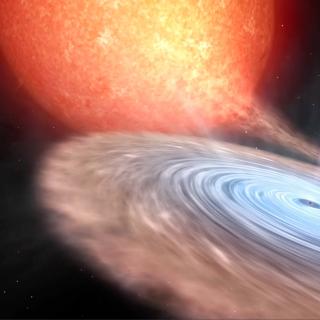Bibcode
Eappachen, D.; Jonker, P. G.; Quirola-Vásquez, J.; Mata Sánchez, D.; Inkenhaag, A.; Levan, A. J.; Fraser, M.; Torres, M. A. P.; Bauer, F. E.; Chrimes, A. A.; Stern, D.; Graham, M. J.; Smartt, S. J.; Smith, K. W.; Ravasio, M. E.; Zabludoff, A. I.; Yue, M.; Stoppa, F.; Malesani, D. B.; Stone, N. C.; Wen, S.
Referencia bibliográfica
Monthly Notices of the Royal Astronomical Society
Fecha de publicación:
2
2024
Número de citas
11
Número de citas referidas
11
Descripción
Extragalactic fast X-ray transients (FXTs) are a class of soft (0.3-10 keV) X-ray transients lasting a few hundred seconds to several hours. Several progenitor mechanisms have been suggested to produce FXTs, including supernova shock breakouts, binary neutron star mergers, or tidal disruptions involving an intermediate-mass black hole and a white dwarf. We present detailed host studies, including spectroscopic observations of the host galaxies of seven XMM-Newton-discovered FXTs. The candidate hosts lie at redshifts 0.0928 <z < 0.645 implying peak X-ray luminosities of 1043 erg s-1<LX < 1045 erg s-1 and physical offsets of 1 kpc < rproj < 22 kpc. These observations increase the number of FXTs with a spectroscopic redshift measurement by a factor of 2, although we note that one event is re-identified as a Galactic flare star. We infer host star formation rates and stellar masses by fitting the combined spectroscopic and archival photometric data. We also report on a contemporaneous optical counterpart search to the FXTs in Pan-STARRS and ATLAS by performing forced photometry at the position of the FXTs. We do not find any counterpart in our search. Given our constraints, including peak X-ray luminosities, optical limits, and host properties, we find that XRT 110 621 is consistent with an supernova shock breakout (SN SBO) event. Spectroscopic redshifts of likely host galaxies for four events imply peak X-ray luminosities that are too high to be consistent with SN SBOs, but we are unable to discard either the binary neutron star or white dwarf-intermediate-mass black hole tidal disruption event scenarios for these FXTs.
Proyectos relacionados

Agujeros negros, estrellas de neutrones, enanas blancas y su entorno local
Los agujeros negros y estrellas de neutrones en binarias de rayos-X son laboratorios únicos para explorar la física de estos objetos compactos. No solo permiten confirmar la existencia de agujeros negros de origen estelar a través de mediciones dinámicas de sus masas, sino que también permiten investigar el comportamiento de la materia y la
Montserrat
Armas Padilla